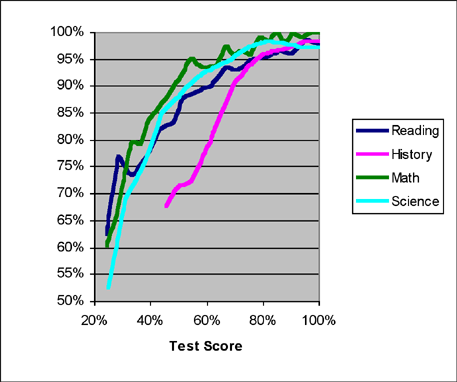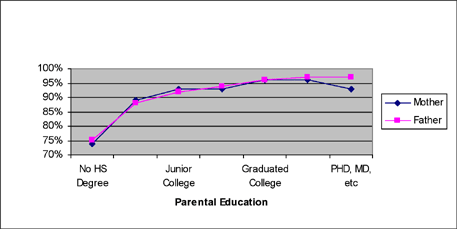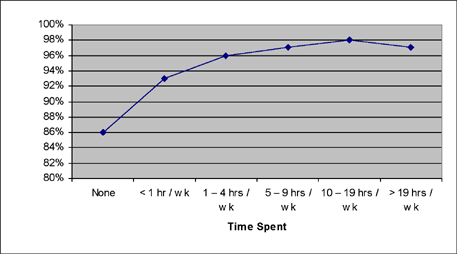August 2005 // Volume 43 // Number 4 // Research in Brief // 4RIB6
Risk Factors Affecting High School Drop Out Rates and 4-H Teen Program Planning
Abstract
The drop out rates of teens in high
school is of great interest to educators across the country. An analysis
has been done to identify the risk factors related to high school drop out
rates. Those risk factors are then related to what educators can do to improve
teen programming efforts as well as decrease high school drop out rates.
Analysis of several databases was performed to compare drop out information.
By determining high school drop out risk factors and relating these data
to 4-H programming, we can begin to draw conclusions and plan strategies.
Introduction
The costs of dropping out of high school can have a profound effect on a young person's life. The relative earnings of high school dropouts are lower than those for students who complete high school and/or college. Similarly, high school dropouts experience more unemployment during their work careers. Young women who drop out of high school are more likely to become pregnant at young ages and more likely to become single parents (Snyder & Sickmund, 1995).
In 1992, the unemployment rate among those dropping out of school was 11%, compared with 7% for those who graduated from high school but did not attend college. The median income among dropouts who were employed full time was only half that of high school graduates. While the real income (income adjusted for inflation) of college graduates has increased during the past 20 years, the real income of dropouts has declined dramatically (Snyder & Sickmund, 1995).
These are sobering statistics when contrasted with the reality of a workplace that continues to require increased literacy, more education, enhanced technical skills, and the ability to embark on careers that require lifelong learning. Without the skills and training that schooling should provide, those who do not complete their education face a lifetime of limited opportunities or even possibly a life of delinquency and crime.
The following data evaluation shows how certain risk factors affect a child's ability to achieve high school graduation. Although 4-H programs are not directly responsible for a child's academic career, Extension programs have a similar goal. The mission of 4-H Youth Development education is to create supportive environments for culturally diverse youth and adults to reach their fullest potential (Colorado 4-H Youth Development Handbook, 2003). Learning to identify proven risk factors in their high school members is the first step in designing successful 4-H programs to meet the needs older youth.
Methods
The following sources of data were analyzed to determine the risk factors directly affecting high school drop out rates:
- The Condition of Education (2003)
- Coming of Age in the 1990s: The Eighth Grade Class of 1988 12 Years Later (2002)
- The Colorado Department of Education Dropout Statistics (1999-2003)
- The 2000 Census of the United States (2002)
Covariant analysis of the data presented by these four sources revealed insight into the risk factors associated with youth dropping out of high school. Using an overall examination of the data, five risk factors were specified as having the largest impact on high school drop out rates. An in depth analysis of the following statistics were performed:
- Test Scores
- Number of Parents
- Both Natural Parents Indicator
- Parent's Educational Attainment
- Time Spent in Extracurricular Activities
- A combination of the above risk factors.
Results
Test Scores
Test scores for Math, Science, Reading, and History were compared to graduation rates. All subjects showed higher scores resulted in higher graduation rates. Math and science scores have the highest correlation to graduation rate (Figure 1). Students who scored 65% on either test had a 95% graduation rate. However, the same scores on the reading test were slightly lower, while history results were the lowest. This data shows that these test scores do not have the same impact as math and science in relation to graduation rate.
Figure 1.
Test Scores

Parental Demographic
Figure 2 shows the Number of Parents and Both Natural Parents Indicators, which were analyzed together. Students reporting three or four parents are interpreted as an indication of a dual custody environment where the student considers two residences to be his or her home. The only households reaching above the national average of 89% for earning a high school diploma were those with both natural parents (Figure 3).
Figure 2.
Natural Parents Indicator

Figure 3.
Mother and Father's
Educational Attainment

Data found in a cohort study evaluating a group of students in eighth grade and then again 12 years later (Ingels, Curtin, Kaufman, Alt, & Chen, 2002), revealed information correlating a parent's educational attainment with their child's graduation rate. Significant increases in graduation rates occurred when parents had earned a high school diploma or attended some college. The only households reaching above the national average of 89% for earning a high school diploma were those where one or both parents graduated from high school.
Extracurricular Activity Participation
Students who are involved in extracurricular activities are more likely to earn a high school diploma (Curtin et al., 2002). An extracurricular activity is defined as an educational activity not falling within the scope of regular curriculum. The sharp difference between no time spent and at least one hour spent per week on extracurricular activities is the most significant portion of Figure 4.
Figure 4.
Time Spent
in Extracurricular Activities

Multiple Risk Factors
During data analysis, a risk factor was assigned to:
- Students who earned a combined math and science score of less than 7200 out of a possible 13000 points,
- Students who did not indicate living with both natural parents,
- Students where both parents did not graduate from high school or one parent did not graduate from high school and the other had no college experience, and
- Students who did not spend time in extracurricular activities.
After compiling risk factors, the number of risk factor points for a student was compared to his/her race and plotted in Figure 5.
Figure 5.
Risk Factors, Race and High School
Diploma Data

The differences between the races are evident in this graph. While a particular race may respond to a different degree than another, all races are affected by the risk factors. Data depart greatly from the group when there are not enough data to make a statement about the population.
Discussion
The data exposes main risk factors that affect a student's ability to graduate from high school.
Test Scores
Students who do better in school, stay in school and are more likely to graduate. The good news is that test scores are available for students as soon as they enter school and take their first test. Once a child, his or her parents, and educators are aware of this risk, the child can be given special attention and encouraged to achieve through specific programs.
Parental Demographic
Although the parental demographic (including number of natural parents in the home, remarriage, education, etc.) is not under direct control, educators should be aware of this factor. If a child's parents did not graduate from high school, he or she is at a much higher risk of not graduating. By encouraging a youth in this situation to achieve higher goals than his or her parents, an educator can make a clear difference in the child's life in terms of success in the workplace.
Extracurricular Activity Participation
Data indicate that students who were involved in extracurricular activities have a greater chance at graduating from high school. If students cease to be involved in extracurricular programs, they will be more likely to drop out of school. It is interesting to note that even 1 hour a week of participation in extracurricular activities has a profound effect on graduation rate.
Multiple Risk Factors
The number of risk factors one child has shows a great effect on dropout rate. Having just one risk factor alters the chance of graduating by a small percentage. With two risk factors, the average drops drastically. Once three risk factors are reached, it drops at an even greater rate. Students with three, four, or five risk factors have similar graduation or drop out rates. More than any single risk factor, the combination of these risk factors together has the most drastic effect on a young person's academic career.
Recommendations
Through the evaluation of data, it is apparent that older teens need assistance when it comes to staying in school and getting a diploma. Any youth program, including 4-H, that wishes to meet the needs of older teens should consider the following.
- Test Scores: To accomplish the goal of designing better programs for teens, educators need to aim at reaching the needs of at-risk youth. The 4-H program should identify 4-H members with low test scores and accommodate them with programs that assist in the areas of math and science.
- Parental Demographic: Educators should increase accessibility to accommodate youth who live in multiple residences, with a single parent, etc. For example, 4-H must accommodate members who spend their summer with a parent not involved with 4-H but who are actively involved as members when with the other parent the rest of the year.
- Extracurricular Activity Participation: Involvement in extracurricular activities increases the chance of receiving a high school diploma. By becoming involved in 4-H, even in a small capacity, youth will eliminate this risk factor.
- Multiple Risk Factors: The most important characteristics
associated with youth dropping out of school are a combination of two or
more risk factors, including:
- Low math and science achievement test scores,
- Not having both natural parents in the home,
- Low parental educational attainment, and
- Limited extracurricular activities.
Educators need to be aware of these risk factors when planning long-term educational efforts. By developing programs and plans of work that meet the needs of teens (listed above), 4-H will retain them longer and they will stay in school longer.
References
Census 2000 summary file 1-4-United States. (2002). U.S. Census Bureau, Washington D.C.
Census 2000 summary file 1-4 technical documentation. (2002). U.S. Census Bureau, Washington D.C.
Colorado 4-H youth development handbook. (2003). State 4-H Program Office, Colorado State University, Fort Collins, C.O.
The condition of education 2003, NCES 2003�067. (2003). U.S. Department of Education, National Center for Education Statistics, Washington, D.C.
Curtin, T.R., Ingels, S.J., Wu, S., & Heuer, R. (2002). National education longitudinal study of 1988: Base-year to fourth follow-up data file user's manual (NCES 2002-323). Department of Education, National Center for Education Statistics, Washington, D.C.
Dropout data. (1999-2003). Colorado Department of Education, Denver, C.O. Available at: http://www.cde.state.co.us
Ingels, S.J., Curtin, T.R., Kaufman, P., Alt, M.N., and Chen, X. (2002). Coming of Age in the 1990s: The Eighth-Grade Class of 1988 12 Years Later. (NCES 2002�321). U.S. Department of Education, National Center for Education Statistics, Washington D.C.
Snyder, H. N., & Sickmund. M. (1995). Juvenile offenders and victims: A national report. Office of Juvenile Justice and Delinquency Prevention, Washington, D.C.
